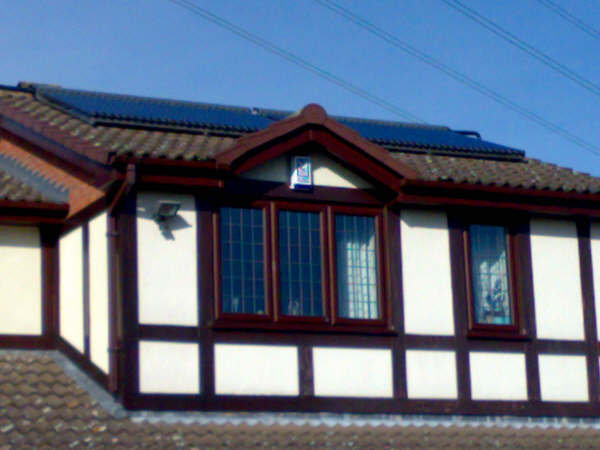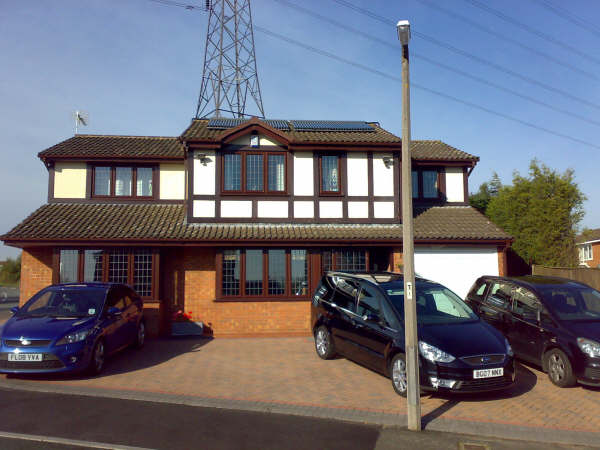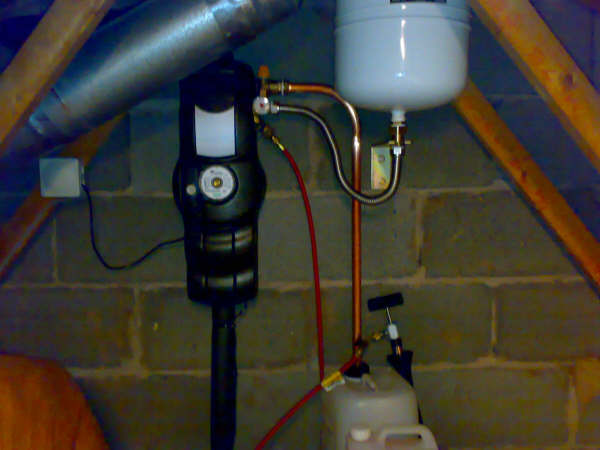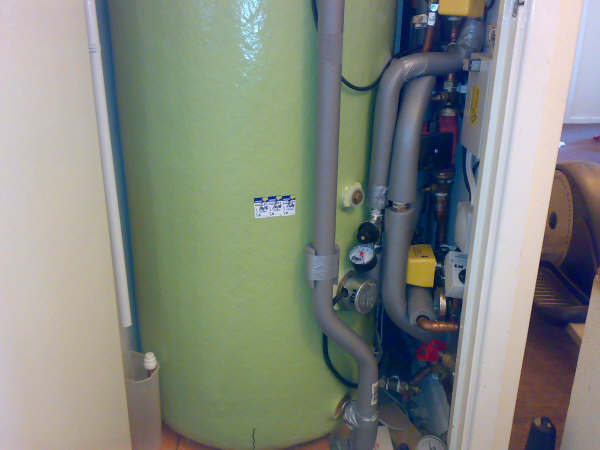|
Home
Solar Thermal
Collectors
Other Parts
Assembly Guide
Installation Guide
Photovoltaics
Collectors
Other Parts
Installation Guide
LED Lighting
Heat Pumps
Rainwater Harvesting
Solar Overview
Customer's
Installations
Glossary
FAQ's
Map
Links
| |
David Satchell bought 2 Eco-58-1800-30 collectors.
David writes:
"Here are a few photo's of our diy installation.
We already had a condensing combi boiler installed and hot water tank thrown out
before we decided to have thermal solar panels, so everything was based around
that. Our methodology was not straight forward in the design.
Materials used:-
2 off 30x58 evac solar panels.
1 off 320 litre 3x coil thermal store.
1 off Domestic hot water expansion tank
1 off solar expansion tank
3 off 2 port zone valves, one for dump the other two for domestic hot water
change over.
1 off Resol controller
1 off Resol pumping station
1 off inline de-aerator (air scoop) fitted before solar pump
2 off mains pressure reducing valves
1 off open vented expansion tank for thermal store
2 off Immersion heaters, one economy 7 and other booster
Various other parts including high temp insulation, oil pump adapted to inject
solar fluid at pressure, thermal store water treatment, non return valves, relay
and junction box, anti surge protectors for the probes, additional probe, tank
thermostats, pipe thermostat, stainless steel roof straps, scaffolding etc.
As we have combined the combi hot water/central heating boiler with the solar
heating system, a few additional challenges and equipment had to be sorted.
The thermal store is initially heated by the solar in the "SUMMER" 'totally' to
increase to useable high grade heat for the hot water, which is mains pressure.
Once the stored hot water is too low in temperature to be of any use for dhw,
there are two in line zone valves which slowly switch over to the combi boiler.
The boiler is natural gas which is cheaper than electricity at present,
this heats the hot water until the solar panel has increased the store
temperature again to useable temperatures with free energy.
The thermal store incorporates a mains pressure hot water coil with thermostatic
mixer valve and shock absorber for the domestic hot water, a solar coil and a
central heating coil (the possibility of legionella if the temperature has not
increased sufficiently to kill bacteria etc would not be a problem as there's
nowhere it can be introduced into the system, and the store is chemically
treated) a concern we looked into. The store is open vented and expansion tank
is connected at the bottom so as not to lose heat from the cylinder into the F &
E tank. This works well. The mains pressure hot water has an
expansion vessel, pressure reducing valves and nrv's fitted to stop over
pressure which might cause tap seals to drip and damage to components and the
tank coil, as mains pressure from water supplier increases to too high a level
at times of low demand.
In the winter months when the solar gain is lower we increase the thermal store
temperature via the central heating after the radiators have been heated, which
gives us the use of the free energy during the winter more readily as the solar
panels heat the store from 65 deg c, making the store useable (high grade
heat) for hot water. However as the central heating is on- any additional
heat energy above central heating temperature that the solar panel has injected
into the store is transferred back into the heating system, so we are now
getting the free energy via the heating.
We have fitted an economy 7 heater and a booster heater in case electricity
becomes cheaper than gas or we fit a wind turbine (a bit expensive at the
moment), although the immersion heaters are too noisy to use during the night.
British Gas economy 7 starts at 22.00hrs so in case we do use it in the future,
I have found that there is a heater on the market having a greater surface area
to reduce kettle noise.
The solar panel pipe work has been routed through gable ends so as not to effect
the integrity of the roof (not so pretty), we chose also not to fit the
automatic air bleed valve on roof as unsightly, instead we fitted two radiator
bleed valves either end of panels and in theory once bled properly there's no
way air can get in, what we had to do is fit an de-aerator before the pump to
reduce pump noise as there were tiny air bubbles in solar fluid, this wasn't
available when first purchased so we added later.
The help and support from Eco-nomical was excellent, on collection of the panels
they opened up shop and carried the equipment over fences and field as they were
under flood conditions from the river, even helping to load. Unfortunately some
equipment that was delivered by carrier was damaged in transit however it was
promptly promptly replaced, a zone valve had stopped working and expansion tank
quick coupler was faulty again no quibbles sent straight out in the post two
separate occasions, fantastic service on top of the extremely competitive
pricing, saving me hundreds of pounds over there nearest competitors who sell in
effect the same under a different disguise I think. When we had to pick up some
replacement tubes on the week end (out of hours) they organised an easy
collection point for me. I'd broken 3 tubes trying to be clever and
carrying tubes in a box up scaffolding and onto roof by myself, broke another
by over tightening clamp as advised by Eco-nomical not to do, oh well you live
and learn and anyway still cheaper and more satisfying doing it yourself!"








Thanks for the comprehensive information, David
|
